The Universe: The Complete Season Four Blu-ray Movie
HomeThe Universe: The Complete Season Four Blu-ray Movie 
A&E Home Video | 2009 | 564 min | Not rated | Feb 23, 2010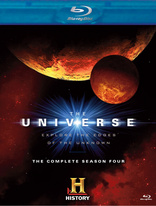
Movie rating
6.9 | / 10 |
Blu-ray rating
| Users | 0.0 | |
| Reviewer | 4.5 | |
| Overall | 4.5 |
Overview
The Universe: The Complete Season Four (2009)
Travel through the galaxies and explore extraterrestrial phenomenon with this sweeping examination of the universe from The History Channel, which uses state-of-the-art computer technology to take viewers up close to distant planets and stars. Topics include black holes, comets, alien galaxies, star deaths, the moon, the interior of the sun and much more. All 13 episodes from the first season are included, plus the bonus episode "Beyond the Big Bang."
Narrator: Erik Thompson| Documentary | Uncertain |
| Nature | Uncertain |
| History | Uncertain |
Specifications
Video
Video codec: MPEG-4 AVC
Video resolution: 1080p
Aspect ratio: 1.78:1
Original aspect ratio: 1.78:1
Audio
English: LPCM 2.0
Subtitles
English
Discs
50GB Blu-ray Disc
Three-disc set (3 BDs)
Playback
Region free
Review
Rating summary
| Movie | 4.5 | |
| Video | 4.5 | |
| Audio | 3.5 | |
| Extras | 2.5 | |
| Overall | 4.5 |
The Universe: The Complete Season Four Blu-ray Movie Review
Space: the final frontier. 'The Universe' makes this particular star trek fun and informative in equal doses. Just try not to let the apocalyptic blather ruin the ride.
Reviewed by Jeffrey Kauffman February 11, 2010If you’re like the majority of us, you’re probably remarkably sanguine about the fact that you exist on a spinning orb of rock that is surrounded by an infinite vacuum. With our human blinders on, blinders which may in fact be necessary to help us cope with the exigencies of everyday life, it’s easy to forget how remarkable the mere fact that we’re here, and in such remarkable circumstances, actually is. The Universe helps to reinstill that sense of wonder, and I was pretty much awestruck by this History Channel series from its very beginning. In fact when I reviewed the first season’s SD-DVD release some years ago for another site, I questioned what was left for the producers to cover since the first several episodes did such a great job of giving the viewer an overview of not only our little spatial neighborhood, also known as The Milky Way, and expanses beyond. I needn’t have worried. The following two seasons of The Universe continued to mine unexpected and often visually spectacular information, and this new fourth season Blu-ray release continues that tradition unabated. It’s encouraging to see how far we home theater enthusiasts have come in a relatively short time, in terms of convincing producers and distributors that we really do want high quality product that exploits the potential of our systems. I have been fairly vocal about History Channel’s lackluster SD-DVD releases, releases which have been repeatedly hampered by not being anamorphically enhanced, something that really disturbed me about the first couple of seasons’ SD-DVD offerings of this visually sumptuous series. Luckily, History heeded the call of, well, history, and has responded to the Blu revolution by giving us a wonderfully realized series presented in great, widescreen glory (and even in 1080p, which means you’re seeing it one “gradation” better than in its broadcast iteration of 1080i). While some may quibble with a mere stereo soundtrack (albeit uncompressed LPCM), there’s still enough here to delight most video- and audiophiles. If the series itself still tends to veer too often into “end of the world” scenarios, something that becomes all to clear when one watches the entire season one episode after another, The Universe is still one of the most compelling pieces that History has yet offered, a superb melding of awesome sights coupled with often mind blowing information. This fourth season contains 12 episodes.
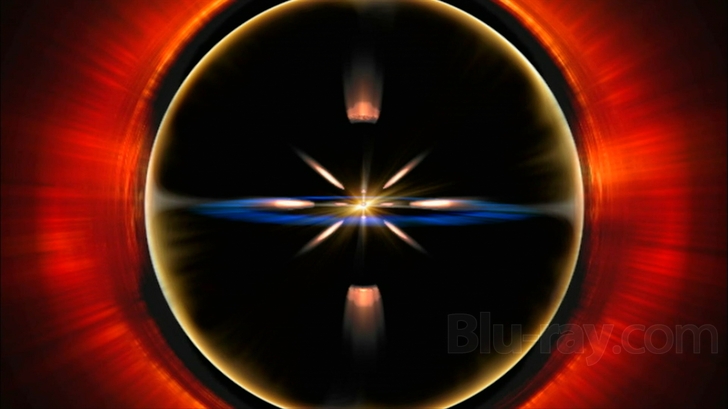
The Ultimate (Digital) Trip.
Death Stars. With a nod toward Star Wars, this episode delves into the perhaps silly apocalyptic fervor which this series tends to visit a bit too often. Concentrating on a giant star in the Sagittarius constellation, known by the less than poetic name of WR104 (the WR stands for the discoverers of this type of star, Wolf and Rayet), this episode posits a number of doomsday scenarios which may occur when the star goes supernova and possibly emits a gamma ray burst. It turns out that Earth lies squarely in the path of said burst, and if the gamma rays make it to our planet, chances are we won’t be around too long to complain about it. Filled with great visuals of black holes, neutron stars (which are kind of like black holes that never quite get to the final level of implosion) and, yes, even a miniskirt clad archer as a female Sagittarius, Death Stars will up your mortality ante despite the odds being rather firmly in your favor. Frequent Universe commentator, University of California Berkeley professor Alex Filippenko seems positively giddy with excitement over the many different ways life may be obliterated by WR104. Note to Alex: you’re supposed to be on our side.
The Day the Moon Was Gone lets us visit apocalyptic worries of a completely different order than those which WR104 may wreak on us hapless humans. This episode is rather peculiarly bifurcated between the first section, which imagines what would happen to our planet if the moon suddenly disappeared, and the second option, which lets us see what the Earth would have been like had the moon never shown up to take residence as our nearest neighbor in space. Neither scenario is particularly appealing, with such oddities as eight hour day-night cycles, and tides which, now ruled solely by the sun, would ebb and flow at exactly the same time every day being the new norm for the planet. Chances are mankind would either never have made it to the playing field or not have lasted very long had he in fact managed to get here to begin with. There is some great footage here showing how our moon did in fact make it into this neck of the universal woods, once an asteroid about the size of Mars, incredibly. Its impact not only knocked the earth onto its now somewhat tilted axis, the satellite itself became our gravitational “anchor” keeping our orbit steady and allowing life to develop over the ensuing millennia. The moon it turns out is actually receding from us at a rate of one and half inches a year, adding about two seconds to our day every 100,000 years or so. Luckily (well, maybe unluckily when you get right down to it), we’re told that by the time the moon finally breaks free of the Earth, the Sun will be about to go supernova and burn us all to toast, so we really shouldn’t worry about it. Thanks, I feel a lot better now.
It Fell from Space might be subtitled the “Chicken Little” episode as it focuses on various threats that penetrate the earth’s atmosphere and have the potential for causing harm and property damage down here on the surface. The episode begins with the only time an asteroid was tracked early enough so that its impending collision with the earth could be monitored. “2008TC3” actually exploded mid-air, but a team of scientists then searched for debris in the Namibian desert and actually managed to find around eleven pounds of meteorites, one of the largest hauls ever. Actually as interesting, if not more so, is this episode’s segments on space debris. Those of you old enough may remember when Skylab began its descent into the atmosphere and the resultant hysteria that ensued. (If I might pay homage to my mother’s rather spectacular sense of humor, this was also in the days of a certain inescapable lip balm commercial and my late mother once told me, “My fervent prayer is that Skylab lands on Suzy Chapstick.”) The episode also goes into longer eons of history, showing the early cosmic attacks on the earth known as the Heavy Bombardment Period, and also spending some time positing what might have happened some 13,000 years ago, when climate change of a huge order wiped out scores of species on our planet.
Biggest Blasts. Not contented to terrorize the audience with mere destruction of our own planet, this episode branches out to discuss huge explosions which have the ability to literally rend asunder entire galaxies. (Once again our friend Dr. Filippenko is back with his curiously grinning explications of how we, and perhaps the entire Milky Way, may meet ignominious ends at the hands of a cosmic detonation). This episode is in fact a sort of “greatest hits” (pun intended) of data (and at times even images) presented in “It Fell from Space” and to a lesser degree “Death Stars.” We’re greeted with admittedly awesome visuals showing planets, solar systems and huge swaths of space being swallowed up by unimaginable amounts of energy being released. “Biggest Blasts” does offer some good lessons in physics and the result of matter being “redefined” as energy as the ten biggest blasts in the universe are counted down until we reach the greatest cataclysm of all, the Big Bang itself. At least that one made something instead of wiping out everything in its wake.
The Hunt for Ringed Planets. Finally with the fifth episode of this fourth season of The Universe, we move away from either ostensible apocalypse or implied death and destruction. This episode starts with a nice in depth examination of our ringed “neighbor,” Saturn, detailing the slow revelation of various rings (the last discovered as recently as 1980), with some great imagery showing what the rings actually consist of (largely ice chunks), and how their apparently smooth surface from our vantage point is a complete illusion resulting from our vast distance from them. The episode then goes into a more generic examination of how rings themselves actually form. In fact it wasn’t until 1977 that scientists were finally able to observe rings on two other planets in our solar system, Uranus and Jupiter, and then shortly thereafter were able to report that Neptune, too, had the phenomenon.
10 Ways to Destroy the Earth. Unfortunately the worst tendencies of this series are once again fully on display in this episode, which once again recounts such supposed threats as gamma ray bursts, as well as perhaps more likely scenarios such as being hit by giant asteroids. This episode actually veers between the sort of silly (alternately being burned or frozen by different orbit paths, which may remind some viewers of the classic Twilight Zone episode “The Midnight Sun”) to the decidedly more fanciful, as several scenarios involving theoretical physics have our poor planet meeting its untimely fate at the hands of such phenomena as strange matter and parallel worlds colliding with us. This countdown episode does offer some great visuals of our lovely blue marble getting blown, melted, burned, broken, crushed and frozen to smithereens, though.
The Search for Cosmic Clusters. In the thousand or so stars which are visible to the naked eye each night, we see a mere shadow of the light contained in huge clusters, the most famous of which is the Pleiades. In fact this episode, which uses the conceit of a virtual spacecraft taking us on a voyage of discovery to various clusters, begins with an exploration of the Pleiades, a “mere” 440 light years from our planet. The Pleiades’ own 1,000 stars (only a handful of which are visible from earth) are dwarfed by the biggest known cluster, some ten thousand light years from Earth, known as Westerlund 1, with an estimated total mass some 100,000 times that of our own sun. This is a spectacular visual feast and one of the most interesting episodes of this season of The Universe, dealing as it does with a lesser known subject and thankfully free of Earth being destroyed every few seconds. Though there is destruction of a cosmic order in this episode, the vast scale of the destruction makes it seem more theoretical and less sensational (in a tabloid sense) than similar “blow ups” in other Universe episodes.
Space Wars. We’re back in silly territory with this episode, which begins with a science fiction look at us 100 years in the future, when a “rogue moon colony” (is there any other kind?) decides to launch a pre-emptive strike at our home planet. “Space Wars” may well appeal to young males (as in pre-teen years), with its coverage of such “cool” weapons as ray guns and lasers. There’s also some sobering footage of current day atomic blasts and what that technology may mean for the weapons of tomorrow.
Liquid Universe starts out by showing us the watery domination of planet Earth, not to mention various other liquids like lava and our planet’s “subcutaneous” lake of iron which make up more than 75% of our home world’s constitution. That of course is the exception to the general rule of the universe, which our old friend Dr. Filipennko explains is largely gaseous in nature. The fact that he makes this statement from inside a pen filled with sheep brings up the whole issue of another kind of gas—biomass, but I will assume that his patented silly smile means he wasn’t surrounded by “strange matter” of that sort when he did his interview. The episode moves on to the moon of Titan, which actually does have liquid, albeit lakes made of methane. The virtual spacecraft which was our transport in the “Search for Cosmic Clusters” episode also takes us to locations featuring more unusual kinds of liquid, as with Jupiter’s hydrogen ocean. This is a really interesting episode with some wonderfully shimmering CGI effects helping to illustrate the various kinds of liquids, rare though they may be, which inhabit the universe.
Pulsars and Quasars is a sterling example of what The Universe really should be doing in more of its episodes: giving us both information and historical context for various scientific discoveries. It may strike some as astounding that it was as relatively recently as 1967 that scientists first discovered pulsars, rotating stars which emit semi-regular pulses of radio activity, which they were at a loss to initially understand, thereby dubbing them “LGM”’s, for little green men. The younger viewers may laugh when seeing a photograph of the four acre radio telescope, such as it was, which first received the “on again, off again” messages from the first pulsar which was discovered. This telescope is basically an assortment of telephone poles and wires that stretches for as far as the eye can see, and it’s an instant visual glyph for how far technology has come in less than half a century. None other than Grateful Dead drummer Mickey Hart is featured setting some groovalicious beats to pulsar data. The second half of the episode ventures further out into space to show us and explicate quasars, huge black holes which are literally eating gigantic amounts of matter and shooting out humongous beams of light and, again, radio waves. Like “Liquid Universe,” this is one of the more visually stunning episodes of this season, with some nifty digital effects showing light and energy zooming through the netherworlds of space.
Science Fiction/Science Fact starts out by paraphrasing Star Trek’s “new life, new civilizations” catchphrase as it discusses some of the ideas and images that have inhabited science fiction through the years. But the episode actually settles down to a kind of cool examination of technologies which may be arriving sooner than you may imagine. We actually do get some Star Trek tie-ins throughout this episode, which at times plays as a puff piece for the J.J. Abrams feature film of last year. And of course the threat of black holes, a plot point in that film, reaches out to digitally touch Earth, destroying all in its wake. Terraforming, a big plot arc in the original Star Trek film franchise, as well as alien invasions (where we get a sort of promo for District 9), and time travel are also covered in this interesting episode.
Extreme Energy brings the fourth season of The Universe to an appropriately dynamic close. After reminding us that everything in the universe is some form of energy, the episode gets into the nuts and bolts of a simple fact which may elude most of us who experience all of the various forms of energy everyday: where exactly does this energy come from? Various modes of energy conversion are also explored, helping to show what new technologies may mean for the future of mankind in space. Examining both the spatial and terrestrial version of solar energy, as well as geothermal energy, this episode does a good job of providing abstract information which can be anchored in more mundane realities of things like heat sources and turning on the lights. The antithesis of these “normal” sorts of energy, dark energy, is covered in the closing segment of this very interesting episode.
The Universe: The Complete Season Four Blu-ray Movie, Video Quality 
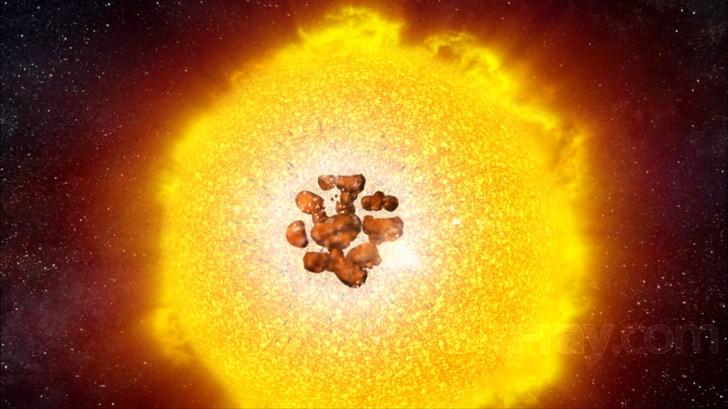
The Universe has always been one of the more visually stupendous series on television, let alone on The History Channel. If the first SD-DVD releases were hobbled by nonanamorphic transfers, that egregious error has been righted since the series made it to Blu-ray. Since The Universe consists so widely of digital imagery, there's no question that the AVC encoded 1.78:1 image is gorgeously sharp and detailed, with amazing, often mind blowing colors. Some of the CGI effects are simply jaw dropping, with huge nebulae seeming to reach up and through the screen, and shafts of light wonderfully illuminating the far reaches of space. Things can get a bit more problematic with some of the source archival footage, some of which seems clearly blown up from 35mm and even 16mm. These archival pieces often are very soft and somewhat degraded, with the expected amount of grain and damage. Contemporary interview segments are sharp and well defined, with great color and detail. This is an awesomely visual series and I'm happy to say that The History Channel has come to its senses with high definition content and is providing stellar (pun intended) product.
The Universe: The Complete Season Four Blu-ray Movie, Audio Quality 
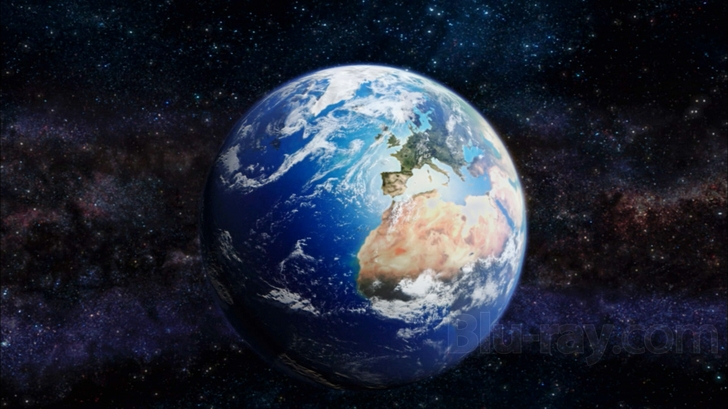
I'm sure there will be some among you who will cry for a surround track to this series, but at least we are offered an excellent uncompressed LPCM 2.0 stereo mix that is, to say the least, robust. This is one of the noisiest documentary series probably in the history of television. The viewer-listener is bombarded with a virtual nonstop array of sound effects, from whooshes and thuds to explosions and outright imaginary sounds fostered by extraterrestrial phenomena. In fact the sheer onslaught of all this aural material can get overwhelming at times, and I wished once or twice that the series would just calm down and give us the glimmering visual side of things without the sturm und drang of the soundtrack. What is here is top notch, with great fidelity and an exuberant dynamic range. There are some fun stereo effects at times, as when a whizzing star zooms from right to left. Narration is always front and center, as are all the on screen interviews, and everything spoken is clear and very easy to hear.
The Universe: The Complete Season Four Blu-ray Movie, Special Features and Extras 
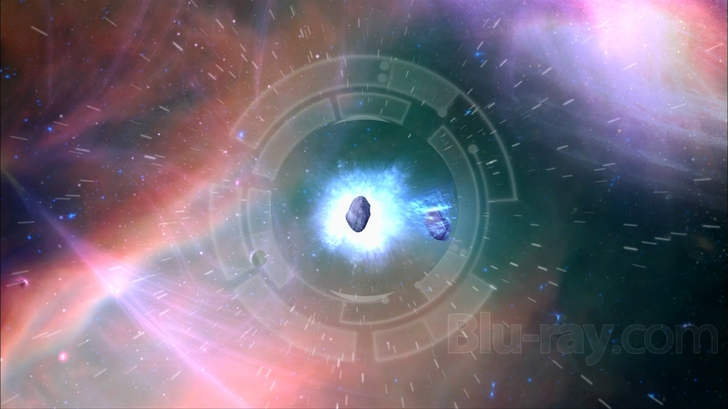
Two brief 1.33:1 720p (MPEG-2 codec) featurettes are offered, "Meteors: Fire in the Sky" (9:33) and "Comets: Prophets of Doom" (3:18). Both play like what they probably were to begin with: filler for the History Channel to get to the next top of the hour.
The Universe: The Complete Season Four Blu-ray Movie, Overall Score and Recommendation 
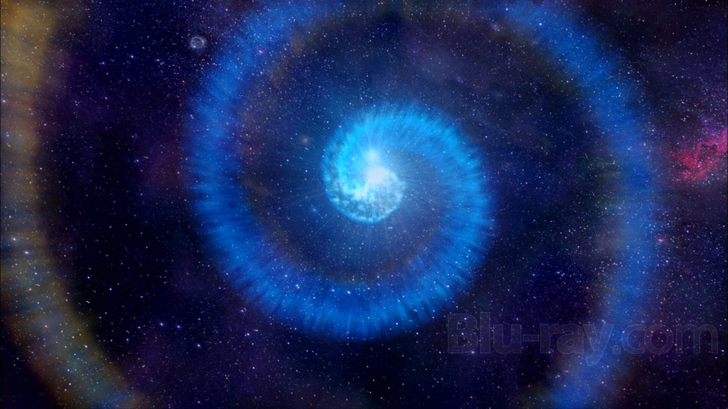
If I may be permitted an intentionally ironic wrap up, I would like to ask the producers of The Universe one simple question: would it really be the end of the world if you stopped focusing on death and destruction and imagined threats and started giving us more fascinating data about this incredible expanse in which we find ourselves? The Universe, both the series and its eponymous source, would be better off for it. This series is still strong and often extremely compelling as it makes its way into middle age, but the ceaseless doom and gloom get a bit wearying at times. Oh, and lest I forget, I have one more slightly tongue in cheek piece of advice: Filipennko, wipe that goofy smile off your face.
Other editions
The Universe: Other Seasons

The Universe: The Complete Season One
2007

The Universe: The Complete Season Two
2008

The Universe: The Complete Season Three
2008

The Universe: The Complete Season Five
2009

The Universe: 7 Wonders of the Solar System 3D
2010

The Universe: The Complete Season Six
2011

The Universe in 3D
2011

The Universe: The Complete Season Seven
Ancient Mysteries Solved
2013
Similar titles
Similar titles you might also like

Wild Ocean
IMAX
2008

Dinosaurs Alive!
IMAX
2007

Journey to the Edge of the Universe
2009

IMAX: Hubble 3D
2010

Grand Canyon Adventure: River at Risk 3D
IMAX 3D
2008

Mummies: Secret of the Pharaohs
IMAX
2007

Ocean Wonderland 3D
2003

History of the World in Two Hours 3D
2011

Space Station 3D
IMAX
2002

Deep Sea 3D
IMAX
2006

When We Left Earth: The NASA Missions
2007

Under the Sea
IMAX
2009

3D Safari: Africa
2011

Sharks 3D
2004

Galápagos
2006

The Ultimate Wave: Tahiti 3D
IMAX
2010

Wonders of the Solar System
2010

WWII in 3D
2011

The Universe in 3D: A Whole New Dimension
2013

Legends of Flight 3D
IMAX
2010